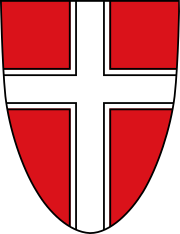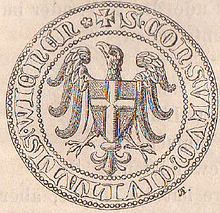Vienna coat of arms
The coat of arms of the federal capital Vienna shows a white cross in a red shield (§ 1 (1) Law on the symbols of the federal capital Vienna ). Today's coat of arms was originally the breastplate of the double-headed eagle coat of arms from the imperial era. The districts of the city conduct their own district coat of arms , which they can use to represent the districts.
The law, § 1. (2) provides for a second form of the coat of arms: The coat of arms can also be used in the form of a breast shield in the figure of a black, gold-armored eagle. This form of the coat of arms is reserved for use by the organs of the municipality of Vienna and the state of Vienna.
The eagle is also shown in the seal of Vienna. § 2. (1) The seal of the federal capital Vienna shows the coat of arms in the breastplate of an eagle. The word sequence “Federal Capital Vienna” or the name of the body of the municipality of Vienna or the State of Vienna that uses the seal must be inserted as the transcription of the seal.
In this form, the coat of arms may only be used by the organs of the municipality of Vienna or the state of Vienna. The same goes for the seal. Although the law provides for the use of the breast-shielded one-headed eagle, it is rarely used in public.
History and meaning
Oldest seal
The history of the Vienna coat of arms goes back a long way and is blurred.
The oldest seals in the city only show an eagle . The eagle is probably derived from the coat of arms of the Babenberg dukes of Austria. The city's oldest seal hangs on a document from 1228. However, it is not clear whether the city actually used these seals as early as 1228. Another seal hangs on a document from 1239, another from 1281. The city used smaller counter and secret seals with the eagle until the 16th century.
At the end of the 13th century the cross appeared, but not in the seal. A coin from 1278 shows four cross-linked signs. The cross itself is probably a reference to the crusades in which some Viennese took part. The colors of the cross, silver in red, as shown on the Reichssturmfahne , come from a book from 1395 and have not changed since then.
The city of Vienna used seals with the Austrian Babenberg coat of arms, the red-white-red shield , from 1360 to the 17th century. However, this seal seems to have only been used for documents related to property transfers. This is probably due to the fact that land acts were carried out by the city directly on behalf of the dukes as sovereigns.
The first combination of an eagle and a cross appeared on a seal from 1327. This shape was used in different variations during the 14th century.
Imperial capital and residence city of Vienna
On September 26, 1461, Emperor Friedrich III. the city the leadership of a double-headed eagle with imperial crown as coat of arms and seal. The binding shield was not mentioned at the time. Although the eagle was ultimately the imperial double-headed eagle , it was not referred to as such. The new coat of arms was intended to underline Vienna's position as the imperial capital and residence. As early as 1463, the city lost this privilege due to its infidelity to the emperor during various wars. The angry emperor transferred the rights to the city of Krems an der Donau , which still bears this coat of arms today.
The city made peace with the emperor in 1465 and was given back the privilege of the coat of arms. This time the eagle was also provided with a cross-tie shield. It is not clear whether this was officially sanctioned to the highest possible degree.
The double-headed eagle with crown and cross-tie shield remained in this version for hundreds of years until 1925. The execution and artistic design changed over time, but the basic components remained the same. In some cases only the shield was used as a coat of arms, but the seal of the city was always with the eagle.
Federal capital
After the end of the monarchy in 1918, a new federal coat of arms was introduced. The local council kept the old coat of arms, but in February 1925 a new coat of arms was introduced after a long debate. The official coat of arms was the shield with a silver cross on a red background. In an additional decision, the use of the simplified one-headed eagle with shield, as it appears on seals of the 14th century, was made.
Corporate state
During the corporate state from 1934 a law on the use of a small and large coat of arms was passed. The small coat of arms was the shield, the large coat of arms was the old double-headed eagle with a crown in the form before 1925. In 1938 the small coat of arms was abolished and the sole use of the large coat of arms was introduced.
National Socialism
After the " annexation of Austria " to the German Empire , the Habsburg house crown above the double-headed eagle was replaced by the Roman-German imperial crown . Otherwise the coat of arms remained unchanged.
After 1945
After the end of the Second World War in 1945, the coat of arms was reintroduced in the form since 1925. Although the double-headed eagle is no longer in use, it can still be found on street lamps, for example.
District coat of arms

District coats of arms are in use for the Viennese districts . The coats of arms were modeled on the seals of the individual districts, which were independent municipalities before the incorporation. The coat of arms of the 1st district, Innere Stadt, shows the same silver cross on a red background as the coat of arms of the city of Vienna. In the legal sense, however, these traditional images lack the character of a coat of arms, as they were never regulated by a state law.
See also
literature
- Peter Csendes, Wolfgang Mayer: coat of arms and seal of the city of Vienna . Wiener Stadt- u. Landesarchiv, Vienna 1986, ( Wiener Geschichtsblätter supplement 1/1986, ZDB -ID 43529-6 ), (exhibition catalog).
- Peter Diem , Michael Göbl, Eva Saibel: The Viennese districts. Their history, their personality, their coat of arms . Deutike, Vienna et al. 2002, ISBN 3-85223-463-8 , ( Perlen series 1010).
- Peter Diem: The symbols of Austria. Time and history in signs . Kremayr & Scheriau, Vienna 1995, ISBN 3-218-00594-9 .
- Franz Gall: Austrian heraldry . Böhlau, Vienna 1996. ISBN 3-205-98646-6 .
- Alfred Grenser : The coat of arms of the city of Vienna. Its creation and history . Vienna, commissioned by Karl Czermak 1866.
- F. Hasslinger. The coat of arms of the Republic of Austria . Publishing house of the Deutsche Verein-Druckerei AG, Graz 1933
- Hanns Jäger-Sunstenau : 500 years of coat of arms letter for the city of Vienna . In: Yearbook of the Association for the History of the City of Vienna 17/18, 1961/62, ISSN 1011-4726 , pp. 53–85.
- Karl Lind: The coat of arms of the city of Vienna. An attempt to establish the history of this coat of arms . Hof- u. State printing office, Vienna 1866.
- Hans Martinek: The little Viennese coat of arms book . Werbena, Vienna 1964.
Web links
- Law on the symbols of the federal capital Vienna issued on February 12, 1998
Individual evidence
- ↑ a b Peter Diem: Red-White-Red through the centuries. The true story of the Austrian colors. (also pdf ) Retrieved May 15, 2009 .






